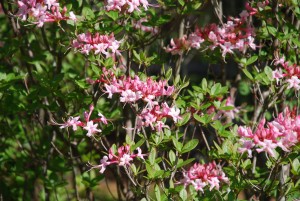Early flowering Piedmont azalea (Rhododendron canescens) is one of the most common native deciduous azaleas in the southeastern U.S. It is frequently confused for pinxterbloom azalea (R. periclymenoides) which blooms 3-4 weeks later. Piedmont azalea is hardy in USDA hardiness zones 6 to 9.
Piedmont azalea reaches a mature height between 6 to 15 feet, about one-third higher than wide. There is great variability within this species. Flower colors may vary from white to deep pink, depending on the seed parentage in the geographic area. The fragrant blossoms appear in early spring before the leaves emerge. Floral stamens protrude outward two to three times beyond the length of the tubular petals. The lightly fragrant flowers invite numerous butterflies, hummingbirds, and bees into the early spring garden.
It is found in deciduous woodlands where it receives ample sunlight in early spring, and stays mostly shaded through the summer months. It prefers a moist, organically rich, well-drained, and acidic soil. Fertilize shrub(s) lightly and add pine straw or pine bark mulch to conserve soil moisture.
Piedmont azalea has a shallow stoloniferous rootsystem, and a shrub may form plant colonies around itself. Prune upright growing Piedmont azalea immediately after flowering to increase shrub density and width. Piedmont azalea is susceptible to a number of eating or chewing pests.


 Posted in
Posted in 
